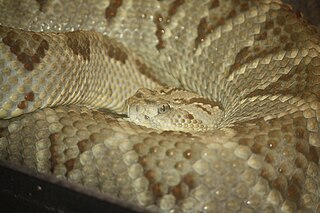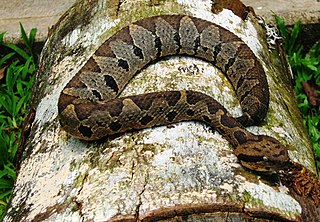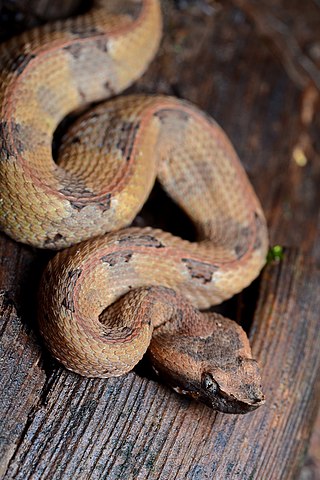
Metlapilcoatlus is a genus of pit vipers endemic to Mexico and Central America. Six species are currently recognized. The common names suggest they are able to leap at an attacker, but this is likely exaggerated. Common names for the species include jumping pitvipers and jumping vipers. The genus name comes from the Nahuatl name metlapilcohuatl, which means of the oblong grindstone held in the hand when grinding corn—alluding to the snake's short, stocky body.

Bothriechis is a genus of pit vipers, commonly called palm vipers or palm-pitvipers found predominantly in Mexico and Central America, although the most common species, B. schlegelii, ranges as far south as Colombia and Peru. All members are relatively slender and arboreal. The name Bothriechis is derived from the Greek words bothros and echis that mean "pit" and "viper" respectively. Ten species and no subspecies are currently generally recognized.

Cerrophidion is a genus of pit vipers which are endemic to southern Mexico, Central America, and western Panama. The generic name, Cerrophidion, is derived from the Spanish word cerro, which means "mountain", and the Greek word ophidion, which means "small snake". Five species are recognized as being valid, but no subspecies are.

Crotalus simus is a venomous pit viper species found in Mexico and Central America. The specific epithet is Latin for "flat-nosed", likely because its head is blunt compared with lanceheads (Bothrops). Three subspecies are recognized, including the nominate subspecies described here.

Crotalus pusillus, or the Tancitaran Dusky Rattlesnake, is a venomous pit viper species found in west-central Mexico. No subspecies are currently recognized.

Crotalus transversus, or the Cross-banded Mountain Rattlesnake, is a venomous pit viper species found in central Mexico, known from less than 20 specimens. No subspecies are currently recognized.
Crotalus totonacus is a venomous pit viper species found in northeastern Mexico. No subspecies are currently recognized.

Bothriechis bicolor is a pit viper species found in southern Mexico, Guatemala and Honduras. The specific name refers to the contrasting ventral and dorsal colors. No subspecies are currently recognized.

Metlapilcoatlus nummifer, commonly known as Mexican jumping pit viper or jumping viper, is a pit viper species endemic to Mexico.

Metlapilcoatlus olmec is a pit viper species found in Mexico. No subspecies are currently recognized.
Atropoides picadoi, also known as Picado's jumping pitviper, is a species of venomous snake, a pitviper in the subfamily Crotalinae of the family Viperidae. The species is endemic to Costa Rica. There are no subspecies that are recognised as being valid. It is monotypic in the genus Atropoides.

Bothriechis aurifer is a pit viper species found in Mexico and Guatemala. No subspecies are currently recognized.

Bothriechis marchi, also known as Honduran palm pit viper and March's palm pit viper, is a species of pit viper, a venomous snake, in the subfamily Crotalinae of the family Viperidae. The species is endemic to Central America. There are no subspecies that are recognized as being valid.
Mixcoatlus barbouri is a pit viper species endemic to Mexico. No subspecies are currently recognized.

Cerrophidion godmani is a venomous pit viper species native to southern Mexico and Guatemala. No subspecies are recognized as being valid. It is also known commonly as Godman's montane pit viper or Godman's pit viper.

Cerrophidion tzotzilorum is a venomous pit viper species which is native to southern Mexico. There are no subspecies that are recognized as being valid.

Porthidium hespere is a venomous pitviper species found in western Mexico. No subspecies are currently recognized.

Porthidium nasutum is a venomous pitviper species found in southern Mexico, Central America and northern South America. No subspecies are currently recognized.

Porthidium lansbergii is a species of venomous snake, a pitviper in the family Viperidae. The species is endemic to Central and South America. Four subspecies are recognized, including the nominate subspecies described here.
Metlapilcoatlus occiduus is a pit viper subspecies endemic to southern Mexico, Guatemala, and El Salvador.


















